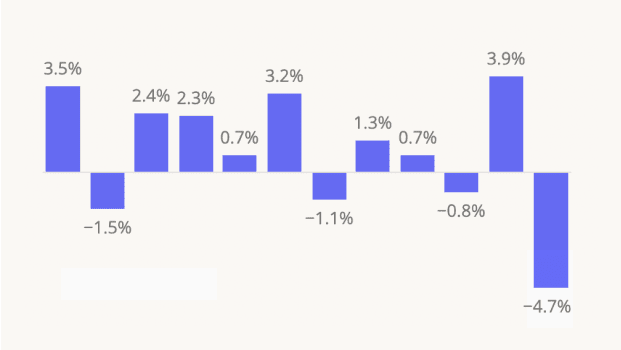The apparel space has faced considerable headwinds in recent years – from changing consumer preferences to cutbacks in discretionary spending. We dove into the data for various apparel categories to explore emerging industry trends and see what foot traffic patterns can tell us about the state of apparel in 2025.
Off-Price and Thrift Gain Relative Visit Share
Consumers’ emphasis on value and the excitement of a constantly changing inventory have significantly impacted the apparel space in recent years – and off-price chains and thrift stores are reaping the benefits.
Between 2019 and 2024, off-price and thrift store chains claimed growing shares of the overall apparel visit pie. Off-price’s visit share jumped from 28.1% in 2019 to 35.1% in 2024, while thrift’s increased from 9.4% to 12.2%. And while this growth came at the expense of traditional department stores and general apparel chains, the relative visit share of our luxury segment remained relatively stable – likely due to its more affluent and less value-seeking clientele.
The activewear and athleisure segment, for its part, has followed a more nuanced path in recent years. The activewear and athleisure segment saw relative visit share growth during the pandemic (between 2019 and 2021), as home workout routines and comfortable clothing became the norm. But in 2022, the category began to revert to its pre-pandemic visit share, likely due to the return of in-person gatherings and return-to-office trends.
Substantive Gains for Off Price and Thrift
Analysis of yearly visits to various apparel categories provides further insight into their foot traffic trajectories.
Since 2021, off-price visits have steadily increased compared to 2019, while thrift store visits have consistently outperformed 2019 levels since 2022. This indicates that the off-price and thrift segments are experiencing absolute visit growth alongside increased relative visit share.
However, over the last four years, visits to traditional department stores and general apparel retailers have consistently underperformed 2019 baselines – while luxury retailers have seen visits decline even as they have maintained relative visit share stability. Meanwhile, following three years of visits above 2019 levels, activewear and athleisure visits have begun to decline, dipping below the 2019 benchmark in 2024.
Singles and Large Families Drive Success
Diving into the audience demographics in the apparel space reveals several trends behind the growth of the off-price and thrift segments.
In 2024, compared to the other apparel categories, off-price had the largest share of large households (3+ people) within its captured market* (42.1%), while thrift stores had the smallest share (39.0%). This could mean that off-price chains resonate with families seeking budget-friendly staples, whereas thrift stores appeal to singles hunting for unique items.
*A category’s captured market is derived by the census block groups (CBGs) from which retailers draw their visitors weighted by the share of visits from each, and thus reflects the population that visits the category.
Consumer Behavior By Apparel Category
Diving deeper into consumer behavior in the apparel space reveals additional visitation trends in the off-price and thrift categories.
Of the analyzed apparel categories, off-price had the longest average visit duration in 2024, followed closely by thrift. Though off-price and thrift formats share a treasure-hunting environment, off-price's higher proportion of larger households may contribute to longer dwell times, as visitors shop for multiple family members at once. Still, thrift store visitors, likely to come from small households, seem to spend significant time treasure-hunting for their own wardrobes. Activewear and athleisure, meanwhile, saw the shortest average dwell time – likely driven by customers who go into the stores knowing exactly what they want.
And of the apparel categories analyzed, thrift had the largest share of weekday visits (Monday - Friday) in 2024, perhaps since its visitors are more likely to be singles and young couples free of family commitments after work or retirees with weekday availability. Still, off-price also had a relatively elevated share of weekday visitors compared to most apparel categories, suggesting that visitors juggling family-driven schedules view off-price shopping as an errand rather than a recreational activity.
Apparel in a Nutshell
Consumer preferences for value and unique finds are reshaping the apparel retail landscape, driving substantial growth in the off-price and thrift segments. While traditional retail models face challenges, understanding these shifts in consumer behaviors and demographics is key to finding success in this dynamic environment.
For more data-driven retail insights, visit Placer.ai.




.png)
.png)

.png)
.png)














.svg)